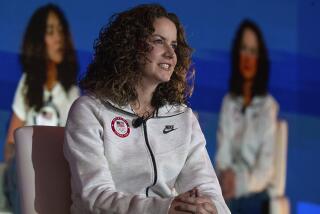For the Ow! Before Wow
- Share via
January is the month for New Year’s resolutions, and with that comes sore muscles from ambitious workouts. Three professionals--a physical therapist, a nutritional consultant and a bodywork educator--talk about how to soothe aching muscles on your way back to buff.
The Physical Therapist
B.J. Fukuji, a supervisor of physical therapy at Centinela Hospital Medical Center, Inglewood
There are two medical theories for sore muscles, Fukuji said: that the muscle tissues have little micro-traumas or micro-tears, or that the tissues have a lactic-acid buildup.
“When we have somebody who comes in real sore, normally what we do is take it easy, [but] we don’t let them not exercise,” she said. “We just back off on the programs,” and there are fewer repetitions.
To ease the pain for hospital patients, therapists use various techniques. Some physical therapists will massage the muscles, using mineral oil or beeswax. For muscle spasm pain, therapists use ice packs; for relaxation or to increase circulation, they use heat.
“We might even use ultrasound. It’s a heating mechanism to the tissues,” she said, “which causes a micro-massaging effect, which will cause heating deep into the tissues.”
Some patients may end up exercising for a while in a pool heated to 96 to 98 degrees Fahrenheit. There they can strengthen and stretch their muscles without fighting gravity.
Centinela is a sports medicine center for many Southern California professional and college teams. Athletes, she said, are a little different than most patients.
“An athlete usually doesn’t pay a lot of attention to pain,” she said. “They think pain is a part of them getting better.”
Having treated jockeys, football players, basketball players, dancers, hockey players and her own four children for the last 25 years, Fukuji has some advice for the regular exerciser: “When you’re going to start an exercise program, start slowly. If you’re sore, then you don’t want to do anything after that. You’ll feel a lot more successful and get better results on a long-term program.”
Her own children are her best example. When they’ve been away from basketball or karate for a few weeks, even these active teenagers get stiff.
“I’ll tell them go ahead and take some warm showers. Drinks lots of [fluids]. Do at least some gentle stretching,” she said.
Nutritional Consultant
Marci Bratman, Westside Acupuncture & Natural Healing, Los Angeles
To help heal the body, Bratman prescribes herbal and food remedies, both as salves and for consumption.
“It’s very important when you’re healing to add fresh organic foods and medicinal foods,” Bratman said.
“Calcium-rich foods are good for muscle spasms--almonds, kale, oats, broccoli, brewer’s yeast, tofu, kefir or nonfat yogurt,” she said.
Magnesium-rich foods, such as whole grains, brown rice, nuts, beans, green leafy vegetables, fish and winter squashes, are also beneficial. And dark-green leafy vegetables, such as collard greens, are excellent sources of vitamins A and C and cleanse the blood.
It’s also important to include foods containing high amounts of vitamin C, such as lemons, oranges, watercress, Brussels sprouts and, again, collard greens.
“The key is to avoid acid-forming foods, such as red meats, caffeine and carbonated drinks during healing. Also, avoid or minimize sugars or saturated fats,” she said. “Sugar depletes the body of important vitamins, specifically B vitamins.”
For healing ointments, Bratman recommended arnica, a homeopathic remedy that is sold as a gel or massage oil.
There are many natural rubs, Bratman said.
“One is called the Rub,” she said. “Everyone calls it the natural Ben Gay.” The Rub contains 21 herbs and five oils and can be used for muscle inflammation or a warmup oil.
For a homemade ointment, Bratman suggested, “mix one part golden seal powder and two parts aloe vera gel and apply topically.”
The Bodyworker
Yamuna Zake, founder of Body Logic, New York
If you tell Yamuna Zake you are stiff and sore from starting an exercise program, she’ll say, “Great!”--after all, you’re supposed to exercise.
But far from being a taskmaster, this bodywork practitioner has developed a healing workout that combines “body meditation and self-massage” with her many years of studying yoga and the human anatomy.
To relieve muscle stress, the New York-based founder of Body Logic said, “the first place to begin is releasing their pelvis, release their legs, free the spine . . . each of the nerve rods.” This will release a general tonic to the body.
Zake’s method, called Body Rolling, incorporates an 8-inch-dense ball into a yoga-like workout. The ball is placed on the floor, and you put your full weight into it, rolling outward from the origin of the muscle.
Zake, co-author of “Body Rolling” (Healing Arts Press, 1997), also teaches sports practitioners how to better train clients. Her philosophy: “If somebody loves something, get them to do it injury-free.”
Her quarrel with many instructors is that they don’t educate clients on the proper way to do things.
People who work out should be realigned four times a year, she said.
“One of the things that’s missing in our culture is the idea that your joints need a grease and lube job on a regular basis,” she said.
But Zake is picky about the “grease and lube job.”
Massage, she said, “does not educate, it’s just feel-good.”
The answer, she said, is to find a reputable practitioner who can teach you about your body so that you work out properly.
“It’s always the practitioner, how good they really are,” she said.
A sign of success for her is to have clients no longer come to her studio for a workout because they can do it successfully themselves.
“Ultimately,” she said, “it’s your body.”


